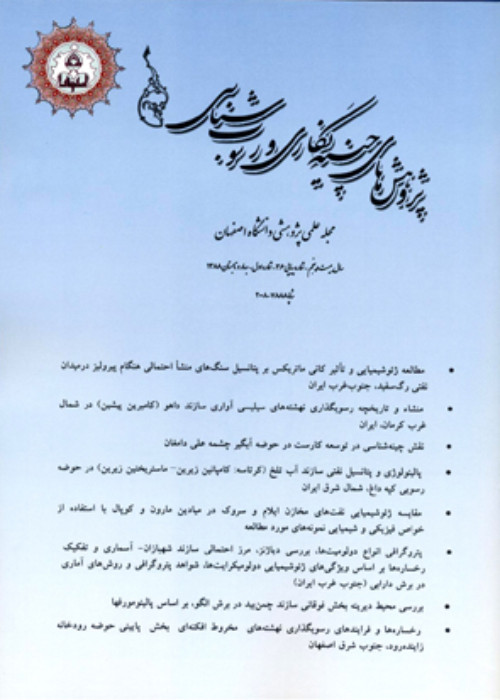Microfacies, sedimentary environment and sequence stratigraphy of the Qom Formation in Yort e Shah no-1 well and Morreh Kuh surface section (South of Tehran)
Author(s):
Abstract:
Introduction
The drilled wells in central Iran basin representing the Oligo-Miocene Qom Formation could be considered as a hydrocarbon system wherever the complete successions of these marine sediments are deposited (Baghbani 1998).Gansser (1955), introduced the Oligo-Miocene marine Formation in the Qom basin and Furrer and Soder (1955) subdivided the Qom Formation in its type locality into six lithostratigraphic units including a to f members ( a basal limestone, b- sandy marl, c- alternating marl and limestone, d- evaporates, e- green marls and f- limestone). Dozzy (1944, 1955) introduced the name of the Qom Formation. Soder (1956, 1959) subdivided the c member into c1 to c4 and Abaie (1964) explained them. The name of the Qom Formation and its members (a, b, c1, c2, c3, c4, d, e and f) have been accepted in National Iranian Stratigraphic Committee since 1975 (Stocklin and Setudehnia 1991).
As the Oligo-Miocene deposits of the Qom Formation posses the high potential for hydrocarbon exploration, they have been subjected to a lot of studies but most of them were focused on central part of the basin. This study represents Sequence stratigraphic analysis based on new biostratigraphic framework and paleoenvironmental interpretations of the Oligo-Miocene shallow water carbonate successions of the Qom Formation in Morreh Kuh surface section and Yourt e Shah No.1 well in the north- east of the central iran basin (Southern Tehran). To set the Qom Formation in a global time framework, the study was carried out in the context of European standard biozonation (SBZ zonal scheme).
Material and
Methods
The studied area is located in back arc basin in the central Iranian Basin. This paper represents sequence stratigraphy of the marine marls, gypsiferous marls, limestone, sandy and silty limestones and evaporates of the Qom Formation in Morreh Kuh (45 m thick) and Yourt e Shah No.1 well (372 m thick) in South of Tehran. In this study 334 thin sections were investigated. In order to evaluate larger foraminifera some examples in several different directions thin section was prepared. In order to determine the larger foraminifera specially, Miogypsinids, multiple thin sections in different orientation were prepared to obtain the oriented sections of this group.The microfacies analysis based on depositional texture, grains (skeletal and non-skeletal) composition, grain size and fossil content. The classification of carbonate rocks followed the scheme of Dunhum (1962) and Embry and Klovan (1971). Microfacies and facie belts were described based on Read (1985) and Burchette and Wright (1992). The age dating of the Qom for is based on larger foraminifera following the European standard shallow benthic zonation by Cahuzac and Poignant (1997). The sequences stratigraphy method is used by Hunt and Tucker (1993, 1995).
Discussion of Results and
Conclusions
From lithological point of view, the Yourt e Shah No.1 well includes c4 to f members. The c4 member contains larger foraminifera as Miogypsinoides gunteri/tani, Miogypsinoides sp., and Nephrolepidina sp. This association marks the SBZ 24 Zone by Cahuzac and Poignant (1997) with the Aquitanian age. The undifferentiated e-f members in this well are marked by larger foraminifera including Borelis melo-curdica, Pseudotaberina malabarica, and Miogypsina gr. globulina. This foraminiferal association correlates with the SBZ 25 Zone revealing the Burdigalian age. In this report Pseudotaberina malabarica for the first time has been reported from Central Iran and Qom Formation.Lithologically, the Morreh Kuh surface section comprises only of the limestone and sandy limestones of the f member which contains larger foraminifera as the following. Borelis melo-curdica, and Austrotrillina howchini. The foraminiferal association could also be correlated with SBZ 25 Zone, referring to the Burdigalian age.
This study shows that sedimentary environment of the Qom Formation is related to a carbonate ramp platform. Based on sedimentary texture and percentage of skeletal and non-skeletal allochems, 2 lithofacies and 9 microfacies from outer to inner ramp were determined. The most part of the Qom Formation in the study area are deposited in inner ramp setting. In the lower part of c4 and undifferentiated e and f member sedimentary environment get deeper and for this reason argillaceous limestone of mid to outer ramp are deposited.
The sequence stratigraphic studies led to the determination of three 3rd order sequences in Yourt e Shah well No.1. The first sequence with the Aquitanian age that includes c4 and d members. The e and f members belong to the second and third depositional sequences with the age of Burdigalian.
In the Morreh Kuh surface section only the youngest sequence with the age of Burdigalian is deposited. The results of the sequence stratigraphic studies showed that toward the North and West of study area the age of the Qom Formation and the sequences get younger.
Keywords:
Language:
Persian
Published:
Stratigraphy and Sedimentology Researches, Volume:33 Issue: 1, 2017
Pages:
25 to 48
magiran.com/p1686359
دانلود و مطالعه متن این مقاله با یکی از روشهای زیر امکان پذیر است:
اشتراک شخصی
با عضویت و پرداخت آنلاین حق اشتراک یکساله به مبلغ 1,390,000ريال میتوانید 70 عنوان مطلب دانلود کنید!
اشتراک سازمانی
به کتابخانه دانشگاه یا محل کار خود پیشنهاد کنید تا اشتراک سازمانی این پایگاه را برای دسترسی نامحدود همه کاربران به متن مطالب تهیه نمایند!
توجه!
- حق عضویت دریافتی صرف حمایت از نشریات عضو و نگهداری، تکمیل و توسعه مگیران میشود.
- پرداخت حق اشتراک و دانلود مقالات اجازه بازنشر آن در سایر رسانههای چاپی و دیجیتال را به کاربر نمیدهد.
In order to view content subscription is required
Personal subscription
Subscribe magiran.com for 70 € euros via PayPal and download 70 articles during a year.
Organization subscription
Please contact us to subscribe your university or library for unlimited access!


